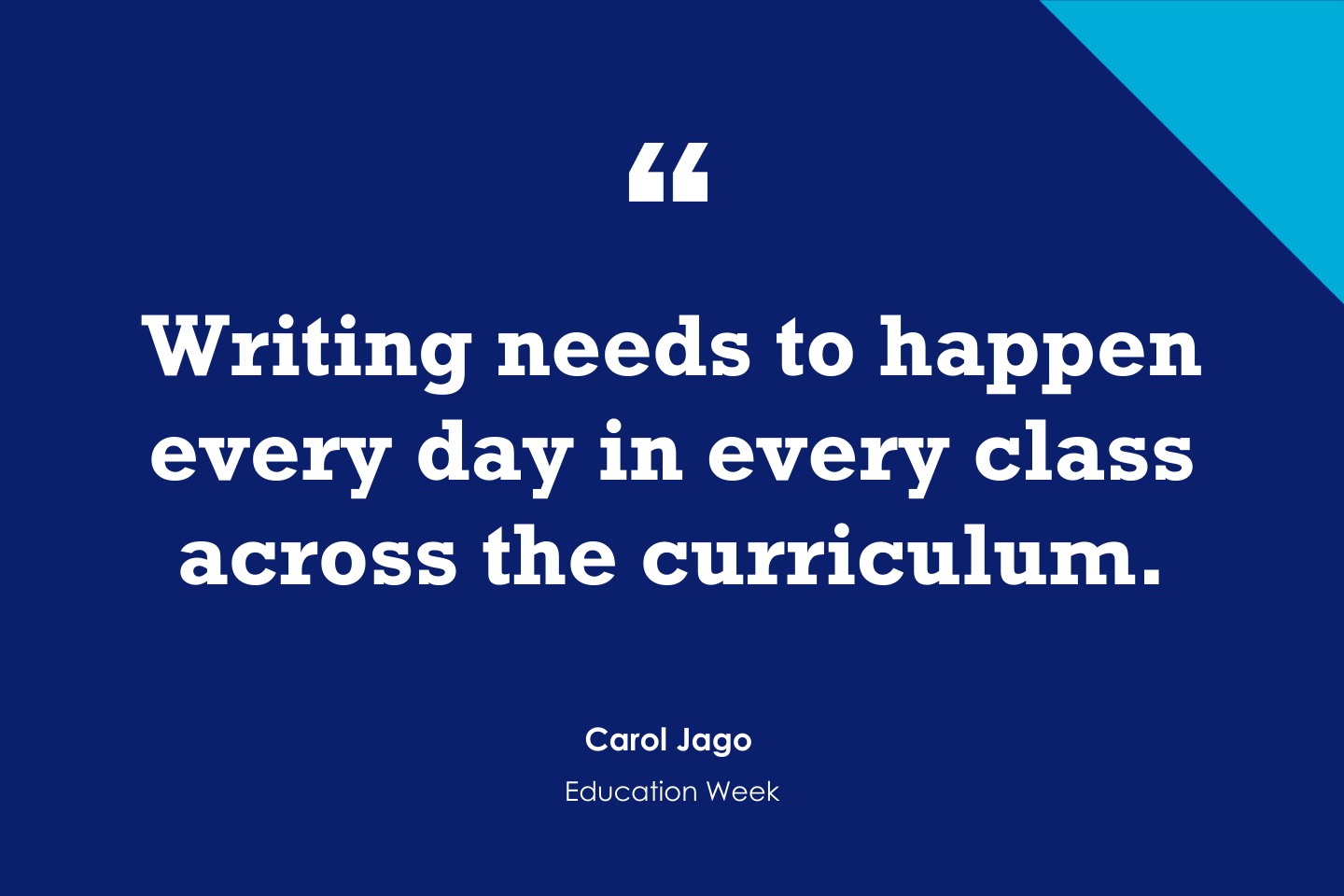
As regular readers know, I’ve been doing the Classroom Q&A column over at Education Week for thirteen years.
And I plan to continue doing it for quite a few more years.
I have so many contributors now, though, that there really isn’t space there for my annual thematic compilation posts, where I collect links to all the posts on particular topics.
So, I’m starting to do it here instead, and this is the fifteenth one.
Today’s theme is on Writing Instruction:
How to Help Students With Their Writing. 4 Educators Share Their Secrets
In many classrooms, students are handcuffed by restrictive templates for assignments instead of getting to practice how to create.
How to Build a Culturally Responsive Community of Writers
Teaching Writing Requires Leaving Students With an ‘I Can Do It!’ Spirit
Three educators share suggestions for writing instruction, including a visual-thinking strategy. Read more.
Four Strategies for Effective Writing Instruction
Three educators share their best ideas on K-12 writing instruction, including writing frames and graphic organizers. Read more.
Seven Strategies for Grammar Instruction
Five educators share instructional strategies for engaging and effective grammar instruction. Read more.
17 Approaches for Encouraging Students to Revise Their Writing
Five educators offer instructional strategies to use when teaching writing revision, including the power of an authentic audience. Read more.
Ways to Help Ignite Students’ Intrinsic Desire for Writing Revision
Five educators make suggestions that might help students want to revise their writing, including by using “editing stations.” Read more.
‘I No Longer Give Grades on Student Writing Assignments, and It’s the Best Thing Ever!’
Five educators share how they have helped students motivate themselves to revise their writing. Read more.
7. Making Revision of Writing a ‘Collaborative Process’
Six educators discuss strategies they’ve used to encourage students to revise their writing, such as demonstrating their own practice. Read more.
8. 12 Strategies for Encouraging Students to Want to Revise Their Writing
Four educators share suggestions for creating the classroom conditions in which students want to make revisions to their writing. Read more.
* Spreading ‘Poetry Love’ in the Classroom
Nine educators share instructional strategies they use to teach poetry, including through read-alouds and through studying and writing odes.
* Teaching Poetry in ‘Playful’ Ways
Four educators share multiple ways to teach poetry, including by modeling and by mimic writing, so that students can enjoy and appreciate the literary form.
Five teachers share strategies for teaching poetry, including by using a “Poem of the Week” to promote social justice and by using photos to prompt student engagement.
* Students Feel More Motivated When Writing for ‘Authentic Audiences’
Shanna Peeples, Mary K. Tedrow, Amy Sandvold, and Laverne Bowers “wrap up” this five-part series on students writing for “authentic audiences.”
* ‘Invite Students to Write Real Arguments’
Rita Platt, Alexis Wiggins, Dr. Jenny Grant Rankin, Kristen Koppers, and Mara Lee Grayson share their ideas on how and why students can write for an audience other than the teacher.
* ‘Design Writing Tasks That Bridge the Gap Between Classroom & Outside World’
Martha Sevetson Rush, Donna L. Shrum, Heather Wolpert-Gawron, Michael Fisher, Tamara Letter, and Keisha Rembert contribute their thoughts on authentic audiences for student writers.
* Ways Students Can Write for ‘Authentic Audiences’
Jayne Marlink, Cheryl Mizerny, Erin Starkey, Nicole Brown, Dawn Mitchell, and John Larmer share their suggestions on how to encourage students to write for “authentic audiences.”
* ‘When Students Send Their Work Out Into the World, It Changes Everything’
Katherine Schulten, Kelly Love, Tatiana Esteban, Kimiko Shibata, Alycia Owen, and Jennifer Orr offer suggestions on how students can write for an “authentic audience.”
* Reading & Writing Instruction in the Age of the Coronavirus
Keep it simple, keep it flexible, and keep the routine familiar are among the suggestions three educators give in assigning students work while distance learning.
* Connecting Reading & Writing ‘Is a High-Leverage Move’
Five educators recommend strategies for using reading instruction as a tool to improve students’ writing skills, including through the use of informal writing and sections of reading texts students can use as models for their writing.
* Ways Reading Can Support Writing Instruction
Five educators share ideas on how reading instruction can help students become more effective writers, including through the use of mentor texts and through a guided step-by-step process.
* ‘Writing Helps Grow Readers’
Assigning students to write about what they are reading and asking them to compose in various formats are among the tips seven educators offer in their discussion of the role of writing in reading instruction.
* ‘Writing Directly Benefits Students’ Reading Skills’
Five experienced educators discuss how writing instruction can support the development of reading skills for students throughout K-12 and provide tips for doing that important work.
* ‘We Should Embrace Writing in Social Studies’
Martha Sevetson Rush, Andrew Miller, Melissa Miles, Donna L. Shrum, and Richard Byrne contribute their thoughts on writing in social studies classes.
* Ways to Integrate Writing in Social Studies Classes
Stan Pesick, Ben Alvord, Dawn Mitchell, Rachel Johnson, and Rebecca Testa-Ryan share their suggestions on integrating writing into social studies classes.
* ‘Not All Feedback Is Created Equal’
The final post in this series on student-writing feedback includes answers from Stacey Shubitz, Carol Pelletier Radford, Melanie Ward, Tasha Thomas, Dawn Mitchell, Jen Schwanke, and Donna L. Shrum. I also share comments from readers.
* ‘Sometimes the Best Student-Writing Feedback Is Encouragement to Keep Going’
Regie Routman, Paul Solarz, David Hochheiser, Kathy T. Glass, Catherine Beck, and Keith McCarroll offer their wisdom on giving feedback to student writers.
* Ways to Give Effective Feedback on Student Writing
Susan M. Brookhart, Ph.D., Cheryl Mizerny, Amy Benjamin, Kate Wolfe Maxlow, Karen Sanzo, Andrew Miller, David Campos, and Kathleen Fad share their commentaries on the best way to provide feedback on student writing.
* Provide Feedback on Writing That ‘Helps Students Tell Their Story’
Anabel Gonzalez, Sarah Woodard, Kim Jaxon, Ralph Fletcher, Mary Beth Nicklaus, and Leah Wilson begin a four-part series on providing feedback on student writing.
* ‘Writing Frames Help Students Organize Their Thinking’
Matthew Perini, David Campos, Kathleen Fad, Jocelyn A. Chadwick, and Diane Mora finish up a three-part series on writing frames.
* ‘Writing Frames Are the Recipes of Writing’
Patty McGee, Jules Csillag, Sara Holbrook, Michael Salinger, and Kathy Glass share their ideas on instructional strategies for teaching writing.
* Strategies for Using Writing ‘Frames’ and ‘Structures’
Beth Rimer, Linda Denstaedt, Gretchen Bernabei, Nancy Boyles, Mary Shea, Nancy Roberts, and Eileen Depka contribute ideas on how to use writing frames and writing structures in the classroom.
* How to ‘Weave Writing Throughout Science Lessons’
Anne Vilen, Sheila Waggoner, ReLeah Cossett Lent, Jason Wirtz, Amy Benjamin, Jennifer L. Altieri, and Fred Ende contribute their suggestions on incorporating writing into science classes.
* Ways to Integrate Writing Into Science Classes
Mary K. Tedrow, Amy Roediger, Dr. Maria Grant,Diane Lapp,Ed.D., Mandi White, Tara Dale, and Becky Bone share their suggestions for how to integrate writing into science classes.
* Mistakes Made in Writing Instruction & What to Do Instead
Lisa Eickholdt, Kathleen Neagle Sokolowski, Mary Ann Zehr, Nancy Frey, and Valentina Gonzalez share their commentaries on writing instruction.
* Avoiding ‘Missed Opportunities’ in Writing Instruction
Eugenia Mora-Flores, Julia G. Thompson, Karen Sher, Bret Gosselin, Dr. Vicky Giouroukakis, and Emily Geltz contribute their suggestions about writing instruction.
* ‘Do Not Grade Every Piece of Writing a Student Creates’
Tan Huynh, Dr. Lynell Powell, Dr. Rebecca Alber, Cheryl Mizerny, Mitchell Nobis, and Kai Marks write about mistakes made in writing instruction.
* We Need to ‘Slow Down’ When Teaching Writing
We finish up this series on teaching writing with responses from Alan Sitomer, Sean Ruday, Jen Schwanke, Heather Wolpert-Gawron, Kathy Glass, Meghan Everette, and Brian Kissel.
* ‘Writing in Math Class Is a Win-Win for Students & Teachers’
Dr. Linda Dacey, Sandy Atkins, Andrea Clark, Mike Flynn, ReLeah Cossett Lent, and Shannon Jones share their ideas on how to incorporate writing into math instruction.
* Writing Instruction & the Common Core—Part Three
This piece features commentaries from Amy Benjamin, Alice Mercer, and from many readers.
* Preparing Students to Write Is ‘About Our Own Collaboration’
Heather Wolpert-Gawron, Kathy Glass, and Carol Jago share their ideas.
* Developing Student Writers by Letting Them Talk …
This post shares commentaries from educators Mary Tedrow, Ray Salazar, and Tanya Baker.
* Many Ways English Teachers Can Improve Their Craft
Author/educators Penny Kittle and Carol Jago contribute their responses.
* ‘Ten Elements of Effective Instruction’
This post includes pieces from Jim Burke and David B. Cohen, as well as comments from readers.
* Many Ways to Help Students Develop Academic Vocabulary
Several educator/authors—Marilee Sprenger; Jane Hill and Kirsten Miller; and Maria Gonzalez—provide guest responses.
* Celebrating Our Students’ Good Writing
This post shares guest responses from three educators: Mary Tedrow, Doug Fisher, and Nancy Frey.
* Helping Our Students Become Better Writers, Part Two
Three educators—Aimee Buckner, Carolyn Coman, and Tanya Baker—contribute their ideas here.
* Helping Boys Become Stronger Writers
Educator and author Ralph Fletcher shares his ideas on how we can specifically help boys become stronger writers.
* A ‘Napkin Curriculum for Writing’
Author and teacher Barry Lane provides his perspective in this post.
* Teaching Writing by Respecting Student Ideas
Teachers Renee Moore and Ray Salazar share their contributions, and I add in my suggestions.
As regular readers know, I’ve been doing the Classroom Q&A column over at Education Week for thirteen years. And I plan to continue doing it for quite a few more years. I have so many contributors now, though, that there really isn’t space there for my annual thematic compilation posts, where I collect links Ed Week Teacher Larry Ferlazzo’s Websites of the Day…





